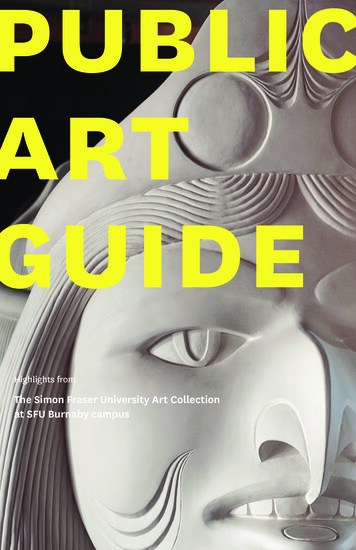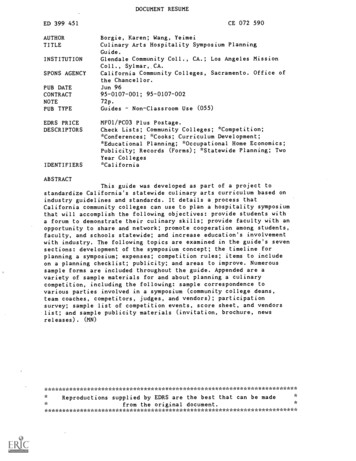
Transcription
publicartguideAlan Woodoil and mixed media on canvas and woodSFU Art CollectionIn the lobby of Strand Hall is a large wooden sculpture by Alan Wood.Adhered to canvas and hung on the wall like a painting, the stackedplywood construction is painted in vivid hues and is typical of Wood’swork. Form and colour in these reliefs are often interpretations ofnatural phenomena, generally distilled through the production of tornpaper collage “studies.” The title in this case suggests a reimagining oforganic materials, interlocking boughs or roots perhaps, as more formalarrangements.Born in Lancanshire, England, Wood (1935–) moved to Vancouver in 1974. He’s had an activepractice from the 1960s through to the present and his work is held in numerous privateand public collections.Highlights fromThe Simon Fraser University Art Collectionat SFU Burnaby campus
Alan WoodAlan Wood1ForestPagoda #3,Fraser1990 University Art Collection is aThe Simonpublic collection of over 5,500 works, many of whichSFUCollectionareArtinstalledwithin university buildings and publicspaces. Managed by SFU Galleries, the collectionwas initiated in 1965 with the commission of twoIn the lobby of Strand Hall is a large wooden sculpture by Alan Wood.tilemosaics by Gordon Smith. The collection hasAdhered to canvas and hung on the wall like a painting, the stackedsubsequentlyto huesencompassa Wood’sdiversityplywoodconstruction isgrownpainted in vividand is typical tationsofof work, with particular strengths in painting,natural phenomena, generally distilled through the production of tornphotography,andby Britishpaper collage “studies.” printsThe title in thiscase sculpturesuggests a ots perhaps,as moreformal ngements.Robert Davidson, Lawren Harris, Roy Kiyooka,KenLum, Bill Reid, Jeff Wall and Jin-me Yoon; andBorn in Lancanshire, England, Wood (1935–) moved to Vancouver in 1974. He’s had an activepractice from the 1960s through to the present and his work is held in numerous private andCanadianand American modern and contemporarypublic collections.artists, including Marcel Barbeau, Jack Bush, JulesOlitski, Robert Morris, Robert Rauschenberg andJean Paul Riopelle. The SFU Art Collection also hassignificant holdings of work by Jack Shadbolt andholds copyright to his work. This guide presents aselection of works in the SFU collection located atthe Burnaby campus.oil and mixed media on canvas and woodoil and mixed media on canvas and woodwalk oneSFU Art CollectionIn the lobby of Strand Hall is a large wooden sculpture by Alan Wood.Adhered to canvas and hung on the wall like a painting, the stackedplywood construction is painted in vivid hues and is typical of Wood’swork. Form and colour in these reliefs are often interpretations ofnatural phenomena, generally distilled through the production of tornpaper collage “studies.” The title in this case suggests a reimagining ofcentral west campusorganic materials, interlocking boughs or roots perhaps, as more formalarrangements.Works sited within the Academic Quadrangle,Born in Lancanshire,England,Wood(1935–) movedto Vancouverincludein 1974. He’s had an activeConvocationMallandWestCampuspractice from the 1960s through to the present and his work is held in numerous privatesomeandofpublicthecollections.earliest works in the SFU ArtCollection, as well as our most recent acquisition.This walk is outside and takes approximately25 minutes.
1Alan Woodbridge beardsleeEnergy Alignment Sculpture:Pyramid in the Golden Section,1976 oil and mixed media on canvas and woodSFU Art Collectionsteel and paintSFU Art Collectionblusson1977hallsaywellGiftof Ian Davidson,hallwest mall centreresidencesdining7 hallvisitor parkade6lorne davies complexw.a.c.bennett libraryconvocationmallsfu theatre32421academicquadranglemaggie 5benstoncentresouthsciencesbuildinghighland courttower roadIn the lobby of Strand Hall is a large woodensculpture by Alan Wood.busAdhered toloopcanvas and hung on the wall like a painting, the stackedplywood construction is painted in vivid hues and orm and colour in these reliefs are often interpretations ofwork.annexnatural phenomena, generally distilled through the production of tornSituated paperwithincollagea hedge-linedenclosure,Sculpture:Pyramid ofin“studies.”The title Energyin this Alignmentcase suggestsa reimaginingappliedsciencesthe GoldenSectionmaterials,is a centralinterlockingwork in theboughsAcademicQuadrangle.for anorganicor rootsperhaps,Producedas more macspyramid – an open, tubular steel frame painted a vivid shade of cerulean blue – iscarefullypositionedto align with the rotation of the earth’s axis and the North Star.technology&Bornin Lancanshire,England, Wood (1935–) moved to Vancouver in 1974. He’s had an activesciencecomplexipracticefromthe1960sthroughto the presentand hisPyramidwork is heldin numerousprivateboth form and spirit, EnergyAlignmentSculpture:in theGolden Sectionand public collections.Inis an apt compliment to the adjacent mounded earth pyramid designed byarchitect Arthur Erickson. Erickson’s pyramid, and Bridge Beardslee’s pyramid– built to the same proportions of the Cheops pyramid in Egypt – both speak toa heightened interest at the time in the monumental works of ancient peoples.In its early years, Energy Alignment Sculpture: Pyramid in the Golden Section attractedunlikely controversy. A debate regarding the correct position required to activatethe pyramid’s “power” played out in the pages of the student newspaper andstudents saw fit on several occasions to “realign” the pyramid – setting it on top ofthe mounded earth pyramid and the student union building for example, beforeit was cemented in its current location.Beardslee studied industrial design at the University of Illinois and then movedto California and worked on the Polaris Missile Project at Lockheed, whileat the same time developing an innovative casting process he used to producearchitectural sculptures.
2Alan Wood3gordonsmith1jacques huetMosaic Mural, 1964Forest Pagoda #3, 1990Arc de Triomphe, 1967Venetiantile media on canvas and woodoil and mixedSFU Art Collectionaluminum withcementoil andmixedbasemedia on canvas and woodSFUArt CollectionCommissioned,1964In the lobby of Strand Hall is a large wooden sculpture by Alan Wood.Adhered to canvas and hung on the wall like a painting, the stackedplywood construction is painted in vivid hues and is typical of Wood’swork. Form and colour in these reliefs are often interpretations ofnatural phenomena, generally distilled through the production of tornpaper collage “studies.” The title in this case suggests a reimagining oforganic materials, interlocking boughs or roots perhaps, as more formalarrangements.Within the Academic Quadrangle are two brightly coloured tile mosaics byGordon Smith, a Vancouver painter who was a friend and sometimes collaboratorBorn in Lancanshire, England, Wood (1935–) moved to Vancouver in 1974. He’s had an activeof SFUfromarchitectArthurThoughSmithis wellknownprivatefor hispracticethe 1960sthroughErickson.to the presentand his workis heldin numerousand abstractpubliccollections.paintings, in the 1960s he began to experiment with op art, flatnessexpressionistand hard-edged line. The tile mosaics were installed when the campus was built in1965 and were the first two works of art acquired by Simon Fraser University. Theorganic forms – bold vermilion orbs set against aqueous blue-green backgrounds– are meant to symbolize energy and growth.Gordon Smith (1919–) was born in England and moved to Canada at the age of15. He studied at the Vancouver School of Art with notable local artists: JackShadbolt, B.C. Binning, Charles H. Scott and Grace Melvin. Best known as apainter and a printmaker he also produced a number of murals for public sitesincluding the Queen Elizabeth Theatre, the MacMillan Bloedel Building andthe Vancouver Law Library. He has participated in numerous exhibitions andhis work is held in public and private collections including the Art Gallery ofOntario, the National Gallery of Canada, the Montreal Museum of Fine Arts, theMuseum of Modern Art, the Smithsonian Institute, the Carnegie Institute, theVancouver Art Gallery and the Victoria and Albert Museum.Alan WoodSFU Art CollectionSFU ArtBrien,CollectionGift of Jacqueline1999In the lobby of Strand Hall is a large wooden sculpture by Alan Wood.Adhered to canvas and hung on the wall like a painting, the stackedplywood construction is painted in vivid hues and is typical of Wood’swork. Form and colour in these reliefs are often interpretations ofnatural phenomena, generally distilled through the production of tornpaper collage “studies.” The title in this case suggests a reimagining oforganic materials, interlocking boughs or roots perhaps, as more formalarrangements.Born in Lancanshire, England, Wood (1935–) moved to Vancouver in 1974. He’s had an activepractice from the 1960s through to the present and his work is held in numerous privateand public collections.North of Convocation Mall outside the Academic Quadrangle is an aluminumsculpture by Jacques Huet. The rough, abstracted figure suggests the blockishform of a horse and rider. Given the title of the work, it is a reference perhaps tothe tradition of equestrian sculptures monumentalizing important men, or morespecifically, the low relief carvings on the Arc de Triomphe in Paris.Huet (1932–2009) was a self-taught Montreal sculptor who worked in wood,aluminum, bronze and plexiglass. Over the course of his career he participatedin many exhibitions and produced public works for sites including OrfordArts Centre, Ministère des Travaux Publics du Québec, Henri-Bourassa subwaystation in Montreal, Centre hospitalier Côte-des-Neiges in Montreal, and Maisondes Arts de Laval.
45elzamayhew1buell mullenAlan WoodGuardian II, 1967Forest Pagoda #3, 1990bronzeoil and mixed media on canvas and woodSFU Art CollectionSFUArttheCollectionGift ofRothmans of Pall MallAlan WoodTheatres of the World, 1964–65oil and mixed media on canvas and woodstainless steel, nickel, gem stones, paintSFU Art CollectionGift of International Nickel Company ofCanada Ltd., 1965SFU Art CollectionCanada Ltd., 1967In the lobby of Strand Hall is a large wooden sculpture by Alan Wood.Adhered to canvas and hung on the wall like a painting, the stackedplywood construction is painted in vivid hues and is typical of Wood’swork. Form and colour in these reliefs are often interpretations ofnatural phenomena, generally distilled through the production of tornpaper collage “studies.” The title in this case suggests a reimagining oforganic materials, interlocking boughs or roots perhaps, as more formalarrangements.In the lobby of Strand Hall is a large wooden sculpture by Alan Wood.Adhered to canvas and hung on the wall like a painting, the stackedplywood construction is painted in vivid hues and is typical of Wood’swork. Form and colour in these reliefs are often interpretations ofnatural phenomena, generally distilled through the production of tornpaper collage “studies.” The title in this case suggests a reimagining oforganic materials, interlocking boughs or roots perhaps, as more formalarrangements.Born in Lancanshire, England, Wood (1935–) moved to Vancouver in 1974. He’s had an activepractice from the 1960s through to the present and his work is held in numerous private andpublic collections.Born in Lancanshire, England, Wood (1935–) moved to Vancouver in 1974. He’s had an activepractice from the 1960s through to the present and his work is held in numerous privateand public collections.South of Convocation Mall outside the Academic Quadrangle is a small, bronzesculpture by Elza Mayhew. Born in Victoria, Mayhew travelled extensively andher modernist sculptures often recall the ancient architectural and monumentalforms that she’d seen in Asia, Europe and Central America. The incised linesand recessed, geometric sections of Guardian II for example, reflect interests inhieroglyphics, the bas-relief carving of the ancient Assyrians, and most notablyin this case, Mayan stelae.Mayhew (1916–) studied French and Latin at the University of British Columbiaand returned to a career in art later in life, completing her MFA at the Universityof Oregon in 1963. She has shown her work internationally and was selected torepresent Canada at the 1964 Venice Biennale. Her work is held in the collectionsof the University of Victoria, the Art Gallery of Greater Victoria, the NationalGallery of Canada, Brock University and Confederation Centre.In the lobby of the Simon Fraser University Theatre are two murals by Chicagoartist Buell Mullen. Mullen developed a method of working on stainless steel –roughing up the surface with a wire brush and then painting with a speciallyground epoxy paint – and produced a number of stainless steel murals for privateand public buildings. The Theatres of the World murals were created during theconstruction of the theatre in 1964, a gift to the University from the InternationalNickel Company (Inco). Notwithstanding forms on the outer edges evokingthe open curtains of a stage, the murals are brightly-coloured, abstract worksencrusted with quartz, gold nuggets and other minerals indigenous to the area.Mullen (1901–1986) was born in Chicago and studied at the British Academy. Bestknown as a muralist she also exhibited work at Salon, Gruppo Moderno and theChicago Art Institute.
76Alan Woodpeterhide1North Face, 1989–1990Forest Pagoda #3, 1990welded steel, stained, varnishedSFU Art CollectionGift of David M. Campbell, 1982Alan Wooddamian moppettaluminum and paintLarge Painting and Caryatid Maquettein Studio at Night (Sculpture Version), 2012Gift of the artist, 2013SFU Art Collectionoil and mixed media on canvas and woodoil and mixed media on canvas and woodSFU Art CollectionSFU Art CollectionIn the lobby of Strand Hall is a large wooden sculpture by Alan Wood.Adhered to canvas and hung on the wall like a painting, the stackedplywood construction is painted in vivid hues and is typical of Wood’swork. Form and colour in these reliefs are often interpretations ofnatural phenomena, generally distilled through the production of tornpaper collage “studies.” The title in this case suggests a reimagining oforganic materials, interlocking boughs or roots perhaps, as more formalarrangements.In the lobby of Strand Hall is a large wooden sculpture by Alan Wood.Adhered to canvas and hung on the wall like a painting, the stackedplywood construction is painted in vivid hues and is typical of Wood’swork. Form and colour in these reliefs are often interpretations ofnatural phenomena, generally distilled through the production of tornpaper collage “studies.” The title in this case suggests a reimagining oforganic materials, interlocking boughs or roots perhaps, as more formalarrangements.Born in Lancanshire, England, Wood (1935–) moved to Vancouver in 1974. He’s had an activepractice from the 1960s through to the present and his work is held in numerous private andpublic collections.Born in Lancanshire, England, Wood (1935–) moved to Vancouver in 1974. He’s had an activepractice from the 1960s through to the present and his work is held in numerous privateand public collections.North Face is a large welded steel sculpture installed in the courtyard of WestMall Centre by Peter Hide. Born in Surrey England, Hide (1944–) undertookstudies at the Crodon College of Art and St Martin’s School of Art, where hewas a pupil of Anthony Caro, before relocating to Edmonton in 1977 to teachat the University of Alberta. Working in the modernist tradition of weldingscrap steel, his works are distinguished by their emphasis on weight, mass andmonumental vertical form.Hide’s work can be found in the collections of the Edmonton Art Gallery, GlenbowInstitute, Mendel Art Gallery, MacDonald Stewart Art Centre, Guelph, AgnesEtherington Art Gallery, Kitchener Art Gallery, and the Tate.Installed on the south side of the SFU Residences Dining Hall, is DamianMoppett’s Large Painting and Caryatid Maquette in Studio at Night (SculptureVersion). In this work the artist has transformed a painting of his studio intoa three-dimensional space, taking abstracted shapes of canvases, lights andsculptures-in-progress and reproducing them as large-scale cutouts in paintedaluminum, such that the final work presents the artist’s studio as a stage set.Originally commissioned by the Vancouver Art Gallery for their OFFSITEspace, the work has been reconfigured for SFU.Moppett is a Vancouver based artist who studied at Emily Carr College of Art andDesign (now University) and received his MFA from Concordia University. Hiswork has been exhibited at Carleton University Art Gallery, Temple Gallery, TylerSchool of Art, Contemporary Art Gallery, National Gallery of Canada, Witte deWith, Vancouver Art Gallery, The Power Plant, Rennie Collection and the Morrisand Helen Belkin Art Gallery, among others.
Alan Wood1Forest Pagoda #3, 1990walk tworobert c.brown hallartsoil and mixed media on canvas and woodoil and mixed media on canvas and woodSFU Art CollectionSFU Art CollectionIn the lobby of Strand Hall is a large wooden sculpture by Alan Wood.Adhered to canvas and hung on the wall like a painting, the stackedplywood construction is painted in vivid hues and is typical of Wood’sw.a.c.work.Form and colour in these reliefs are often interpretationsbennettoflibraryest mallcentrenatural phenomena, generally distilled through the production of tornpapercollageThe titlein this case suggests a reimagining rtationorganic materials, interlocking boughs or roots perhaps, as more formalconvocationmallcentrearrangements.This short walk along the north concourse ofsfu theatreBornin AcademicLancanshire, England,QuadrangleWood (1935–) moved to Vancouverin 1974. He’sahadan activethenumbercampus highlightspractice from the 1960s through to the present and his work is held in numerous private andsecuritypublic collections.of works from the SFU Art Collection.s complexsAlan Woodeducationbuildingsaywellhall1325 Strand7 lobby46In theofHall is a large wooden sculpture by Alan Wood.Adheredtocanvasandhung on the wall like a painting, the stacked10 98plywood construction is painted in vivid hues and is typical of Wood’swork. Form and colour in these reliefs are often interpretations ofstrandnatural phenomena, generally distilled through the productionhall of tornpaper collage “studies.” The title in this case suggests a reimagining oforganic materials, interlocking boughs or roots perhaps, as more formalarrangements. academicquadrangleBorn in Lancanshire, England, Wood (1935–) moved to Vancouver in 1974. He’s had an activepractice from the 1960s through to the present and his work is held in numerous privateand public collections.sciencesterry foxfieldsouthsciencesbuildingtechnology &science complex 2
12Alan Woodsusanpoint1Written in the Earth, 2000Forest Pagoda #3, 1990cast aluminum and red cedarOn loan from the collection of George and Christiane Smythoil and mixed media on canvas and woodSFU Art CollectionAlan Woodjim hartFrog Constellation, 2000cedaroil and mixed media on canvas and woodCollection of Bill Reid FoundationSFU Art CollectionIn the lobby of Strand Hall is a large wooden sculpture by Alan Wood.Adhered to canvas and hung on the wall like a painting, the stackedplywood construction is painted in vivid hues and is typical of Wood’swork. Form and colour in these reliefs are often interpretations ofnatural phenomena, generally distilled through the production of tornpaper collage “studies.” The title in this case suggests a reimagining oforganic materials, interlocking boughs or roots perhaps, as more formalarrangements.In the lobby of Strand Hall is a large wooden sculpture by Alan Wood.Adhered to canvas and hung on the wall like a painting, the stackedplywood construction is painted in vivid hues and is typical of Wood’swork. Form and colour in these reliefs are often interpretations ofnatural phenomena, generally distilled through the production of tornpaper collage “studies.” The title in this case suggests a reimagining oforganic materials, interlocking boughs or roots perhaps, as more formalarrangements.Born in Lancanshire, England, Wood (1935–) moved to Vancouver in 1974. He’s had an activepractice from the 1960s through to the present and his work is held in numerous private andpublic collections.Born in Lancanshire, England, Wood (1935–) moved to Vancouver in 1974. He’s had an activepractice from the 1960s through to the present and his work is held in numerous privateand public collections.Installed in the atrium at the northeast corner of the Academic Quadrangle isWritten in the Earth, four aluminum and cedar works by Susan Point. The designs,featuring faces flanked by animals, represent the diversity of world cultures.Blue Herons (2008), a series of carved wooden panels installed in the Technology &Science Complex I, are also by Point.Point (1952–) is a Coast Salish artist from Musqueam Nation. She’s produced anumber of prominent works for public sites including Musqueam WelcomeFigures (1996) and Flight (Spindle Whorl) (1995) at the Vancouver InternationalAirport and People Amongst the People (2008) at Brockton Point in Stanley Park.Her work is held in many public and private collections and she has been therecipient of numerous honours and awards including an honorary degree fromSimon Fraser University.Outside the Museum of Archaeology and Ethnography is Frog Constellation, alarge cedar carving by Jim Hart depicting a man and a woman on the back ofa giant frog. As a creature that moves between worlds, the frog is a powerfulsymbol for the Haida and a family crest of the Eagle clan. The work was inspiredby a smaller shamanic object, carved by an unknown Haida artist in the 1870s,that the artist saw in a photograph. In 2007 Frog Constellation was acquiredby the Bill Reid Foundation and the Bill Reid Centre for Northwest Coast ArtStudies at SFU.Hart (1952–) was born in Massett and currently lives and works in Vancouver andHaida Gwaii. He began carving in the late 1970s, apprenticing first with RobertDavidson and then with Bill Reid in the early 1980s. An established Haida artist,Hart has produced a number of significant commissions and his work can befound in public collections around the world.
3Alan Wood1lynnvardeman4Alan Woodjohn innesNorthern Light, 1983Forest Pagoda #3, 1990Six Paintingspolyesterresinmedia on canvas and woodoiland mixedSFU Art CollectionSFUArt CollectionPurchase,1984oil on canvasoil and mixed media on canvas and woodSFU Art CollectionArt CollectionGift of Post SFU#2 NativeSons ofBritish Columbia, 2004In the lobby of Strand Hall is a large wooden sculpture by Alan Wood.Adhered to canvas and hung on the wall like a painting, the stackedplywood construction is painted in vivid hues and is typical of Wood’swork. Form and colour in these reliefs are often interpretations ofnatural phenomena, generally distilled through the production of tornpaper collage “studies.” The title in this case suggests a reimagining oforganic materials, interlocking boughs or roots perhaps, as more formalarrangements.In the reflecting pool outside the north concourse of the Academic QuadrangleBorn in Lancanshire, England, Wood (1935–) moved to Vancouver in 1974. He’s had an activeis a pinkishthat atto thefirstglance,appearsto inbenumerousa rock,privatebut ispracticefrom theform1960s throughpresentand hiswork is heldandin fact apubliccollections.polyesterresin sculpture by Vancouver artist Lynn Vardeman. Known primarilyas a filmmaker and photographer, Vardeman began to work with sculpture inthe early 1980s. She was particularly interested in experimenting with resincasting and the capacity of resin to transmit light and reflect colour.Born in Chicago, Vardeman studied art in San Francisco before moving toVancouver in 1968 to do graduate work at the Vancouver School of Art (nowEmily Carr University of Art and Design). Vardemann taught for many years inthe department of visual arts at SFU.In the lobby of Strand Hall is a large wooden sculpture by Alan Wood.Adhered to canvas and hung on the wall like a painting, the stackedplywood construction is painted in vivid hues and is typical of Wood’swork. Form and colour in these reliefs are often interpretations ofnatural phenomena, generally distilled through the production of tornpaper collage “studies.” The title in this case suggests a reimagining oforganic materials, interlocking boughs or roots perhaps, as more formalarrangements.John Innes (1863–1941) was born in London, Ontario but moved West,Born in Lancanshire, England, Wood (1935–) moved to Vancouver in 1974. He’s had an activeworking practiceas a surveyorRail inthepresent1870s andandhissettlingin Vancouverthefrom the for1960sCPthroughto thework is heldin numerous inprivateearly ctingWesternand public collections.landscapes and scenes derived from his personal experiences as a frontiersmanand cattle wrangler. In 1924 Innes was commissioned by the Native Sons of BritishColumbia, a fraternal organization that worked to promote local histories, toproduce a series of eight paintings depicting historical events in British Columbia.These paintings were acquired by SFU in 2004 and hung in the north concourseof the Academic Quadrangle. The works, which in many cases presentedEuropean explorers as sovereign authority figures, reflected ways of thinkingabout history and the settlement of British Columbia that were out of stepwith contemporary views of colonization. Students and faculty successfullylobbied university administration to remove Alexander Mackenzie RecordingHis Arrival at the Pacific, A.D. 1793 and James Douglas Building the Hudson’s BayPost at Victoria, A.D. 1843, two of the more controversial paintings. The Innespaintings continue to hang in the north concourse as a reminder of these layeredhistories and the lessons these histories bear.
56Alan Woodcharlescomfort1British Columbia Pageant, 1951Forest Pagoda #3, 1990oil on canvasSFU Art CollectionGift of Toronto Dominion Bank, 2003Alan Woodd’arcy henderson[Negative #1] Adam/Eve, 1969fiberglassSFU Art CollectionPurchase, 1970oil and mixed media on canvas and woodoil and mixed media on canvas and woodSFU Art CollectionSFU Art CollectionIn the lobby of Strand Hall is a large wooden sculpture by Alan Wood.Adhered to canvas and hung on the wall like a painting, the stackedplywood construction is painted in vivid hues and is typical of Wood’swork. Form and colour in these reliefs are often interpretations ofnatural phenomena, generally distilled through the production of tornpaper collage “studies.” The title in this case suggests a reimagining oforganic materials, interlocking boughs or roots perhaps, as more formalarrangements.In the lobby of Strand Hall is a large wooden sculpture by Alan Wood.Adhered to canvas and hung on the wall like a painting, the stackedplywood construction is painted in vivid hues and is typical of Wood’swork. Form and colour in these reliefs are often interpretations ofnatural phenomena, generally distilled through the production of tornpaper collage “studies.” The title in this case suggests a reimagining oforganic materials, interlocking boughs or roots perhaps, as more formalarrangements.Bornin Lancanshire,England, isWood(1935–) movedVancouverin 1974. He’shad anandactiveBritishColumbia Pageanta 21-metrelongto muraldepictingeventsnarrativespractice from the 1960s through to the present and his work is held in numerous private andwithinthe founding and settlement of the province. Originally commissionedpublic collections.by the TD Bank for their branch at the corner of Granville and Pender, the muralshows a meeting between Spanish explorers and Nootka Chief Maquinna, thearrival of Captain Vancouver, and artist Emily Carr, against a backdrop of imagesof exploration, logging, and a modern city skyline.Born in Lancanshire, England, Wood (1935–) moved to Vancouver in 1974. He’s had an activepractice from the 1960s through to the present and his work is held in numerous privateand public collections.Comfort (1900–1994) was a Canadian artist who was active in the 1930s and 1940s.He developed a reputation as a painter of murals, producing panoramic paintingsand carved friezes for the Arts & Letters Club in Toronto, The Toronto StockExchange, and Central Station in Montreal.When British Columbia Pageant was installed at SFU in 2004 it met with controversyfor its depiction of a history that begins with the arrival of Europeans and itspromotion of industry. Some referred to British Columbia Pageant as “monumentalkitsch” while others suggested the mural promoted a “retrograde history.”Student-led efforts to formulate a response to the Comfort mural are evident in“anti-colonial” artworks installed opposite the painting.Below British Columbia Pageant is [Negative #1] Adam/Eve, a minimal blacksculpture of a large circular form, split and divided in the middle, by D’arcyHenderson. Henderson began his career as a photographer whose interest inilluminating textured surfaces – fiberglass and flaked glass for example – ledhim to produce three-dimensional forms. Taking leave of photographic ends,sculptural works such as [Negative #1] Adam/Eve were designed to be definedand shaped by light.Henderson (1940–2002) was born in Princeton, BC and studied at the VancouverSchool of Art. He was an active member of the Vancouver arts community inthe 1960s and 1970s, teaching at Emily Carr College of Art, Capilano Collegeand the University of British Columbia, and participating in exhibitions at theArt Gallery of
Moppett’s Large Painting and Caryatid Maquette in Studio at Night (Sculpture Version). In this work the artist has transformed a painting of his studio into a three-dimensional space, taking abstracted shapes of canvases, lights and sculptures-in-progre










